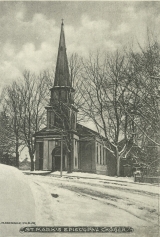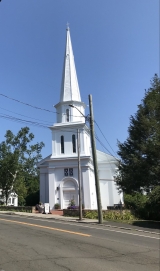5 Oenoke Ridge
Next door to the New Canaan Museum & Historical Society in the building that now houses St. Michael’s Lutheran Church was St. Mark’s Episcopal Church, photographed c. 1912. Even though it was built in 1834 and hails as the oldest church in New Canaan, this was not its original location. The first church was located about three-quarters of a mile northwest near the cemetery located at the bottom of West Road. Construction on this church began in 1764 and does not seem to have ever been finished. Perhaps due to its incompleteness, or that it was possibly never consecrated, the church was never given a name, but was referred to as the “Episcopal Society in Canaan Parish.” It was finished enough to allow services though, but services were only held sporadically. For nine months out of the year, parishioners had to travel eight or so miles to worship in Stamford or Norwalk.
Eventually in 1791, New Canaan parishioners voted to separate from the Stamford and Norwalk parishes and to form their own.
In 1832, work began on the second Episcopal church located today at 5 Oenoke Ridge. The land was purchased by Captain Stephen Betts of the Continental Army and Edward Nash for $200 and construction finished in 1834. Research is inconclusive as to why it was named for St. Mark except that the building committee first convened on April 25 1832 – the Feast of St. Mark, and typically a church was named after the saint who had the closest holy day when construction began or when the building was consecrated. However on that day, the committee simply voted to build a stone wall on two sides of the property, which it seems was enough to claim the name of St. Mark.
In 1857, St. Mark’s went under major renovation. The changes included adding a steeple and basement, reshaping the windows, and lengthening the building. While this major overhaul was underway, services were held in the Town House, which now contains the offices of the New Canaan Museum. It was perhaps at this point that the church was first painted brown. “The little brown church on the hill” remained shades of brown until it was painted its current white in 1921.
For a few months in 1944, the Congregational and St. Mark’s churches held combined services on Sundays. In the fall of that year, the parish discovered that the roof of the Congregational church was no longer stable and services could not be held there while the repairs were being done. Originally, the Congregational Church was meeting in the Playhouse, but the Rector at St. Mark’s suggested the services be combined at St. Mark’s church. The choirs were combined, the organists took turns playing, and Father Barton and Reverend Merrill Clark alternated preaching.
Plans to build a rectory had been bandied about starting all the way back in 1847, but it was not until 1882 that it was built. For approximately $3,360, the church built 51 Main Street, the former Red Cross building. The church sold the house in 1923 and bought what is now 24 Oenoke Ridge as their new rectory. That house was then sold in 1949 when the church purchased the McLane Property, which would later become the site of the modern St. Mark’s Church.
By 1949, it had become clear that the parishioners had outgrown their church. As is the case with these sorts of plans, work on building the new church did not begin until 1955. After much deliberation, the architectural firm Sherwood, Mills & Smith of Stamford was selected. The church leadership also decided that the new church would not be styled along the lines of a traditional New England church. This of course upset many people, who had a few years earlier sent in lines of verse to the Advertiser to complain about the likes of Philip Johnson, Eliot Noyes, and their “packing box” like modern homes. Eventually, after much deliberation, the members of St. Marks approved the modern design. The ground breaking ceremony occurred on October 4, 1959, and after $1.7 million was spent on construction, the church held its first services on October 8, 1961. The old church building was sold in the spring of 1961, and rechristened as St. Michael’s. After some remodeling, the first Lutheran service was held in the church on September 30, 1962.
“New Canaan Now & Then” is presented in partnership with the New Canaan Museum & Historical Society.



Thank you for this article. I was baptised in the old St. Mark’s in 1940. Many years later taught Sunday school in the rectory on Oenoke Ridge. Nursery through 3rd grade were their as there was no room in the church for all grades. The assistant rector performed a short children’s service. I was at the ground breaking service for the new church.
I no longer live in New Canaan but enjoy New Canaanite and look forward to New Canaan Then and Now.
Of course I love the article! The reason it was painted brown is that in 1857, when it was remodeled in the Italianate Style, with round-arched windows and entrance door, there had been a reaction to the white Federal and Greek Revival buildings. This movement away from Classical (white) buildings was led by the architect Andrew Jackson Downing, who popularized the Gothic Revival in America with his early architecture books, promoting buildings that blended with the landscape and were “pointy,” like the evergreen trees. (think Vine Cottage). Window and door trims were to be painted a darker brown. He disdained the white houses with columns for standing out in the landscape, not blending with it. The Italianate style followed, with round-topped windows, heavy bracketed cornices, square towers and either a continuation of the brown siding or, now, a reintroduction of white buildings. Not until the full impact of the Colonial Revival Style in the 1880’s was felt, was white paint applied to everything, especially after the 1893 Chicago World’s Fair – the “White” or “Alabaster City.” For some strange reason that seems to be the story today in New Canaan for both old and new houses, many with black windows. I should add that white paint was rarely if ever used before the Federal period – it was made with lead and was unavailable or very expensive in the 18th century.